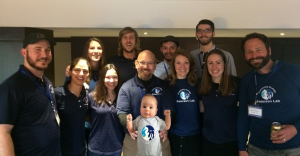The Peterson Marine Community Ecology Lab is seeking to interview and select six to eight (6 – 8) highly motivated volunteer research assistants this summer to work on several dissertation and monitoring projects (for a partial list of projects, see below). Research hours can be used towards research credit hours with Dr. Bradley Peterson.
Volunteers will be asked to commit at least two days per week (preferably consecutive days) from June through August. Exact starting and end dates are negotiable.
***We are also seeking one person who would be able to work intensively with Amanda Tinoco on a specific project (examining the effects of predator acoustic cues on mud crab consumption of blue mussels) five days per week for the month of June.
We specifically look for people who are comfortable and enjoy being outdoors, especially in the field on boats and in the water. Volunteers should be in good physical shape and enjoy hands-on work. Ability to swim is a requirement.
If interested, please send your CV/resume, research interests, and a list of available meeting times to Diana Chin, diana.chin@stonybrook.edu. Alternatively, feel free to contact a lab member regarding a specific project listed below. (Please note that with the exception of Amanda’s experiments in June, it is unlikely that you will work exclusively on one project. Our philosophy is that exploring a variety of research questions and methods is essential to your scientific development!)
Summer Projects:
Contact: Rebecca Kulp, rkulp1@gmail.com
I will be looking at how prey mobility affects foraging efficiency of crustacean mesopredators across varying habitat types and densities. Prey preference between mobile and sessile prey will also be evaluated using consumption rate, handling time, and encounter rate.
Contact: Diana Chin, diana.chin@stonybrook.edu
This summer’s research will involve a field experiment to evaluate whether the commensal relationship between seagrass and a species of chemosymbiotic clam (which “eats” sulfide in sediment) changes across a gradient of light exposure to the seagrass. I will also be using field tethering experiments to look at whether seagrass can provide a predation refuge for the clam.
In addition, I’m looking for someone who wants to come to Panama in fall 2016 to do tropical clam and seagrass research!
Contact: Steve Heck, heck.stephen@gmail.com
This summer, I plan on looking into how several species of larger fish predators influence community structure in seagrass ecosystems. More specifically, I aim to look at how larger fish predators govern the feeding activity and abundance of crustacean mesopredators that prey on bay scallops and how this influences the survival of these bivalves. This will involve a combination of field and mesocosm experiments.
Contact: Amanda Tinoco, amandaisabeltinoco@gmail.com
My research will focus on the effects of predator acoustic cues on the foraging behavior of mud crabs on blue mussels. Work will consist of helping set up and break down mesocosm experiments as well as going out in the field to collect organisms for my experiments. This work will be primarily completed during the month of June.
Other Monitoring and Research:
Beyond the projects above, the lab will be conducting water quality assessments in Jamaica Bay, Great South Bay, Shinnecock Bay, and Peconic Bay; hard clam condition assessments for Great South Bay; and a shellfish-based restoration project in Great South Bay.
